Wealth Inequality Caused the Great Recession
In his OP-ED piece titled “The GOP’s Suicide March” (WaPo, January 19, 2012) Charles Krauthammer says: “Now, economic inequality is an important issue, but the idea that it is the cause of America's current economic troubles is absurd.” Oh?
Krauthammer labors under the same misapprehension and shallow economic thinking afflicting most of the mainstream press. They just don’t know how to connect the dots between wealth inequality and America’s economic troubles. Allow me.
The rich skew the game in their favor so they wind up with 87% of national income gains during Reagan, 98% during Bush 43 (compared to 35% before Reaganomics). How?
Start with cutting the top income tax bracket from 70% to 28% during Reagan’s watch. The cuts more than double the take-home pay of the CEO earning $10 million per year. (At 70%, the CEO gets to keep $3 million, at 28% he gets to keep $7.2 million, 2.4 times as much as before without without lifting a finger. Presently the rate is 35%, meaning the CEO’s take-home pay merely doubled with no increase in his compensation.) The percentage reduction diminishes as you move down the income scale until at the lowest tax bracket you actually get a tax-rate increase from 14% to 15%. So much for the “fairness” of “across-the-board” tax cuts.
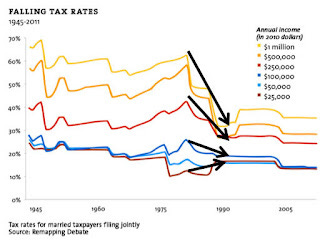
To add insult to injury, Reagan increases FICA and Medicare taxes by 61%, ostensibly creating a surplus to pre-fund anticipated increases in baby-boomer Social Security and Medicare costs. Such increases are borne primarily by working class Americans who pay 15% (employer/employee contribution) FICA and Medicare taxes on all their pay (up to $106,800 currently), compared to the relatively few C-Suiters for whom the tax is a minor annoyance since they stop paying FICA after $106,800, meaning for our $10-million-a-year CEO the tax represents something like 0.18% of his pay.
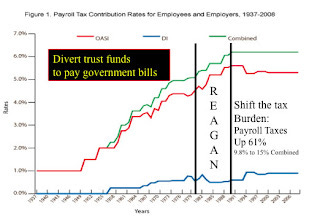
Instead of setting the FICA/Medicare surpluses aside to pay for the anticipated surge in Baby-Boomer retirement benefits, reprehensibly Washington spends it on wars, offsets to tax cuts for the rich and routine expenses. Whereas had they set the money aside they would have bought government bonds on the open market, creating unused debt capacity, or, in the best of circumstances, actual surpluses, instead the government spent it all and inserted unissued new bonds into the Trust Funds, which merely signals the government’s intent to borrow and add to the national debt to pay for the Boomers’ increased retirement benefits when they become due.
Next, cut taxes on capital gains from ordinary income rates to 28% under Reagan, 20% under Clinton (at the insistence of Republicans) and 15% under Bush 43. Since most of the income for the super-rich is derived from capital gains (see Mitt Romney), they wind up paying an effective federal tax rate of around 18% compared to around 27% for median-income taxpayers. Hence Warren Buffet’s comment about the unfairness of his secretary paying a higher tax rate than he does.
Next, allow all manner of tax dodges to corporations, especially on foreign income and tax-haven corporate HQ’s, so as to steadily diminish the corporate share of total federal taxes, including excise taxes which are mostly corporate. (See graph below.)
The net effect of all this chicanery (falsely presented as “job creation” for the working class) is to steadily shift the tax burden from the rich to working-class taxpayers. In the graph below, notice how the corporate share (including excise taxes) is steadily diminishing, leaving more room for boosts in C-Suite compensation.
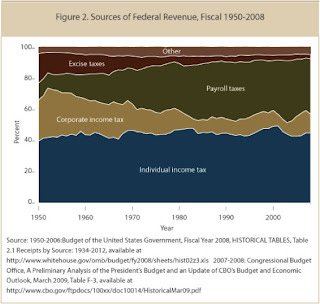
2. Reduce regulation to as to plump up the corporate bottom line by eliminating pesky costs of observing regulations intended to prevent pollution, enhance worker safety and deal fairly with customers and investors.
Fatter corporate profits mean more pay for C-Suite executives and more dividends for investors (who are mostly wealthy), but no gains for working-class employees who haven’t had a real pay increase in more than 30 years. See graphs below. Notice how corporate profits are rising as a percent of National Income, whereas employee compensation is going down. So much for “Trickle-Down Economics.”
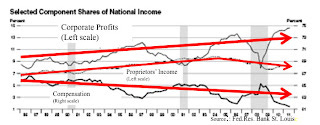
3. Engage in Long Wars, which serve little purpose other than to provide defense contractors with long, lucrative contracts, again fattening corporate profits, C-Suite compensation and dividends mostly for the rich.
Tax cuts, less regulation, Long Wars. That is how the rich game the system so as to scoop up the vast bulk of newly created wealth. The net effect of Reaganomics? The rich get fabulously richer, the poor get desperately poorer and the middle class marks time.


Here’s where Krauthammer and others fail to connect the dots:
Wanting to keep the American Dream alive, the stagnant middle class and as many of the poor as are able, make up the shortfall between their aspirations for consumption and their dismal incomes with debt. And where do they obtain credit? From the rich, who, after all are the ones with money to lend. (Foreigners and the Fed are also sources of credit, but for purposes of simplicity and illustration I will concentrate on wealthy American lenders.)
A. The excessive debt owed by middle- and lower-class to rich Americans is both produced by and evidence of income inequality.
In short, distribution of income overwhelmingly favoring the rich at the expense of the middle and lower classes is what produced the excessive debt that is at the heart of America’s financial and economic problems. It was the over-extension of mortgage credit (extended by the rich who had to put their money to work, along with foreign creditors and an over-accommodative Fed) that created the housing bubble. In addition, the superabundance of lendable funds stemming largely from wealth inequality, eventually resulted in the lowering of lending standards and, with regulators asleep, the over-extension of credit to un-creditworthy borrowers. ”Sub-prime” borrowers, in Wall Street-speak, were inveigled by unscrupulous mortgage brokers into taking out variable-rate mortgages at a time of unusually low mortgage rates. When mortgage rates returned to normal, borrowers could not make the payments, defaulted and started a cascade of foreclosures which brought down the housing market, creating the Panic of 2008 and the ensuing Great Recession.
B. Further, the means by which inequality of wealth is produced -- namely tax cuts favoring the rich, reduced regulation and Long Wars favoring corporations acting as funnels of income to the rich — contribute to huge federal deficits, starting with Reagan:
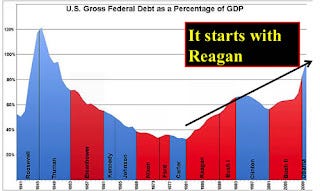
The deficits building ever since Reagan, coupled by Republican intransigency in raising taxes (and, indeed, calls for yet further tax cuts), have undermined the ability of the Obama administration to revive the economy with emergency spending, due to legitimate fears of overburdening future generations with debt. Such emergency spending is needed to supplant flagging consumer demand so as to provide incentives for business to hire. In the absence of adequate emergency spending, recovery has been lackluster and reductions in the unemployment rate have been sluggish, again tying back to the means by which inequality of wealth is engineered by wealthy political benefactors: low taxes, less regulation and Long Wars.
Bottom line: Reaganomics got us into this mess and is preventing us from extricating ourselves from it.
So, Mr. Krauthammer, far from being absurd, growing economic inequality is, in fact, the cause of America's current economic troubles.


